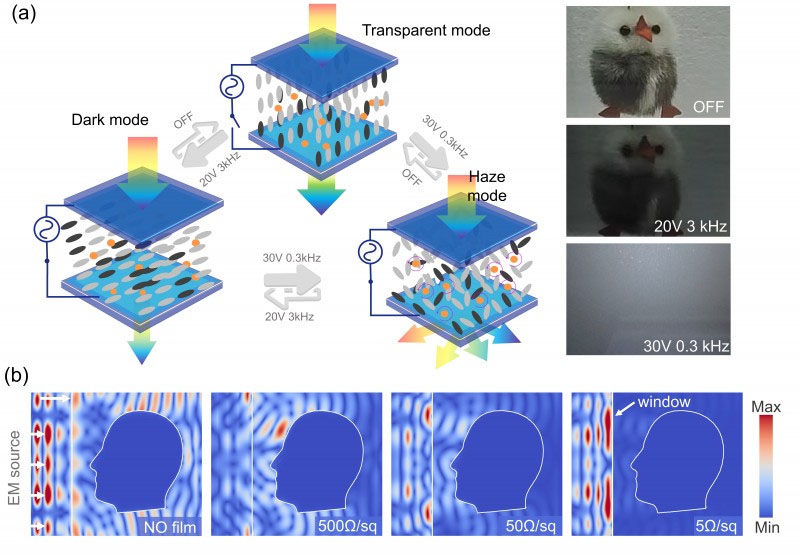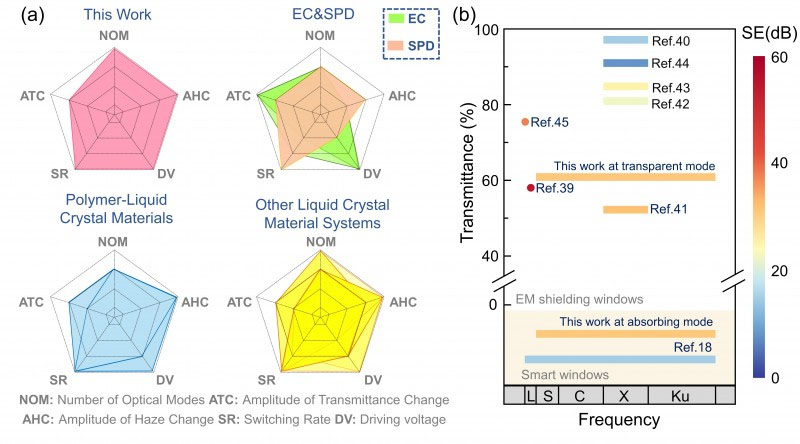| Sep 04, 2024 |
Multispectral smart window
(Nanowerk News) Windows serve as crucial interfaces between indoor environments and the outside world but are also key entry points for harmful light and electromagnetic (EM) waves. Typically, managing the transmission and scattering of light requires different materials and devices. An often overlooked yet essential aspect of smart window technology is EM modulation. Consequently, windows capable of both regulating visible light and shielding against EM waves are increasingly necessary.
|
|
A research team led by Professor Jiaqi Zhu from Infrared Films and Crystal introduces a novel multispectral smart window that can modulate visible light while simultaneously blocking microwave signals. The window's structure includes a core mixture of negative liquid crystals, ionic surfactants, and dichroic dyes, layered with vertically aligned polyimide and an indium tin oxide (ITO) film, all encapsulated within a glass substrate.
|
|
The findings are published in Light: Science & Applications ("Multispectral smart window: Dynamic light modulation and electromagnetic microwave shielding").
|
 |
| Figure 1: a, Schematic diagram of different mode dimming control strategies and effects for the tri-state switching multispectral smart window. b, Electric field analysis of the human head behind the window with different resistance values at 5 GHz wave incidence. (© Light: Science & Applications)
|
|
As illustrated in Figure 1(a), the combination of dynamic scattering and liquid crystal doping allows precise control over light transmittance and scattering, enhancing energy efficiency and privacy. Additionally, optimizing the ITO film's thickness enables effective microwave shielding without compromising optical performance, thereby reducing health risks associated with the increasing prevalence of 5G networks, as shown in Figure 1(b).
|
|
When comparing current electronically controlled smart windows and transparent structures for microwave shielding, this study reveals significant improvements across five areas: response time, transmittance adjustment range, haze adjustment range, driving voltage, and optical modulation mode, as demonstrated in Figure 2(a). Furthermore, as seen in Figure 2(b), the new technology outperforms existing transparent electromagnetic shielding materials across several shielding bands, including S, C, X, and Ku bands. Its electromagnetic shielding capabilities also substantially exceed those of commercially available PDLC materials.
|
 |
| Figure 2: a, Research status of electronically controlled smart windows (EC, Electrochromic smart window; SPD, suspended particle devices). b, Research status of microwave shielding transparent material. (© Light: Science & Applications)
|
|
In summary, this research introduces a cutting-edge multispectral smart window technology that mitigates electromagnetic pollution while dynamically adjusting sunlight through transitions between transparent, absorbing, and haze states. Using an innovative ion movement model and dielectric constant operation strategy, the optimal ratio of CTAB to SDS was identified, achieving a lower driving frequency (~300 Hz) to avoid electrical breakdowns common at higher frequencies.
|
|
Moreover, by optimizing the thickness of the transparent conductive film, the study significantly enhanced the broadband electromagnetic shielding effect to 30.9 dB while maintaining optical transparency. This work represents a valuable step forward in the coordinated design and optimization of smart windows for managing both the solar and microwave spectra.
|


